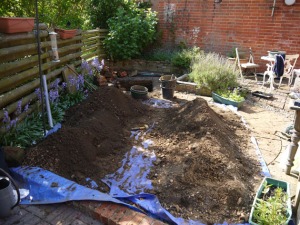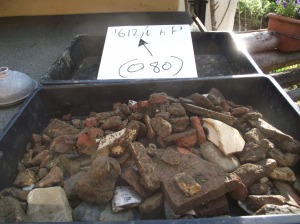Test Pit 5: High Street
1st June 2013 & 28th June 2014
By Martin Cuthbert
Test Pit 5 was located on the east side of the High Street at its northern end, just southeast of “Castle Mound”, a scheduled ancient monument. The property is a beautiful timber framed house, most likely of 16th-17th century date.
The purpose of the castle mound is still unknown. Was it a Medieval motte and bailey castle? A prehistoric or Saxon burial mound? We hoped this test pit could answer these questions, and to discover whether an earlier property had once stood on the site.
1st June 2013
Topsoil overlay a dark garden soil which contained an assemblage of pottery of differing ages, some animal bone and clay pipe stems. We discovered a brick wall very early on which ran diagonally across the test pit. Once below the last bricks, we were able to remove the wall and continue down. We think the wall once formed a garden feature and was probably 19th-20th century in date. Sadly the wall restricted our progress and we weren’t able to go as deep as we hoped, but an assemblage of medieval pottery was recovered from both made ground deposits within TP5, dating to 900-1600. The assemblage suggests that there has been continuous habitation on the site from the late Saxon period onwards.
28th June 2014
One of the reasons to return to test pit 5 was because we weren’t able to go as deep in 2013 because of the wall that hindered us. The assemblage of Saxo-Norman pottery from the intial excavation was one of the largest assembleges of pottery of Saxo-Norman date found in Wing and gave us good reason to return and see what else we could find deeper down.
We weren’t disappointed…….
A large feature of unknown proportions was identified within test pit 5. Its last fill (079) produced a large assemblage of Saxo-Norman pottery (AD 900-1350) and a small assemblage of early-mid Saxon pottery (AD 400–800) , indicating this feature had fallen out of use and was back filled by c. AD 1200.
This feature and the associated pottery are the first clues to where the mid-late Saxon settlement activity was occurring prior to and during the early stages of construction of Wing church and the village itself. Saxon settlement is known to be dispersed and not focused around a church or village green like those of the medieval period, and these findings indicate mid-late Saxon settlement activity is occurring on the site.
The findings tentatively suggest that the High Street and Stewkley Road may be of historic origin and the junction between them an important strategic location.
A huge thank you to all our volunteers, members of LBDAHS, Paul Blinkhorn for the pottery analysis and Heather for allowing us to dig the same hole in her garden, twice.













